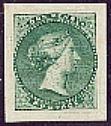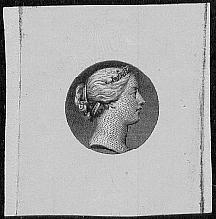The Small Queens
Proofs
|

Die Essay Proof
|
It
seems likely that the vignette was based on a design produced by the British
security printers, Bradbury Wilkinson & Co., which in turn was modelled on
the portrait of the young Queen Victoria made by the English engraver Mr.
Charles Henry Jeens. It seems more than co-incidence that the portrait adopted
by Canada faced to the right rather than the normal left. Plate proofs of this
design, which was basically for trade sample purposes are not difficult to find
in various colours, the most desirable of which is black. Die proofs are another
matter and it is believed only one exists. |
|
In
order to produce the vignette of the Large Queen Half-Cent value, an impression
was taken from the Large Queen vignette
master die, and the circumference reduced, slightly off-centre cutting off the
tip of the base of the neck. It was necessary to do this off-centre to keep the
portrait centred (!) in the smaller format. It seems likely that no die proofs
of the Large Queen series vignette survives; I know of only two of the smaller
vignette, proofed for the Half-Cent Large Queen and then employed for all the
Small Queens other than the diminutive Half Cent of 1882, and the Eight Cents
where the portrait is virtually a mirror image of that of the rest of the series.
One was in the 1969 Robson Lowe ‘Glassco’ sale, and I haven’t seen it
offered since, the other was in one of the Maresch ‘Simpson’ sales. It would
be of great interest if anyone knows of other copies.
|

Vignette
|
This
vignette was used, as said, for the bulk of the series, the scroll work probably
being done first, then the vignette die impressed on to the work in progress and
finally the wording and value were added to complete each die. Only ONE die was
made for each value. Additionally some essays were made, that is for a design
that was not adopted in the case of a rejected One Cent design, or values that
were never issued in the case of a Twelve-&-a-Half Cents and Fifteen Cents
values. The first because reductions in postal rates made the denomination
redundant, and the second because the Fifteen Cents plate never needed to be
replaced.
All
die proofs of the series are rare and pricey. Plate proofs are also much sought
after and as a result are not cheap either.
The
standard work on Canadian proofs is a book by Messrs Pratt and Minuse published
in 1979. Apparently they were unaware of the small vignette proof as it is not
listed. It did list an alleged essay of the Six Cents with a portrait of a Queen
with a blunt nose, determined jaw, the neck brutally chopped off at the back,
and where the style of lettering is quite unlike anything used by the British
American Bank Note Company, and the ornamentation is heavy handed which seems,
like its co-horror, a Two Cents, to have been accepted unquestioningly by many.
Since the item is printed on gummed paper, a highly unusual practise as
there was no reason to gum Die Proofs – if the printer wanted one stuck
to card he used glue – it is surprising that the status of these items,
illustration 39B-E in the book, does not seem to have been challenged. Unless
someone can come up with a provable respectable provenance, I fear they are
nothing but out and out forgeries.